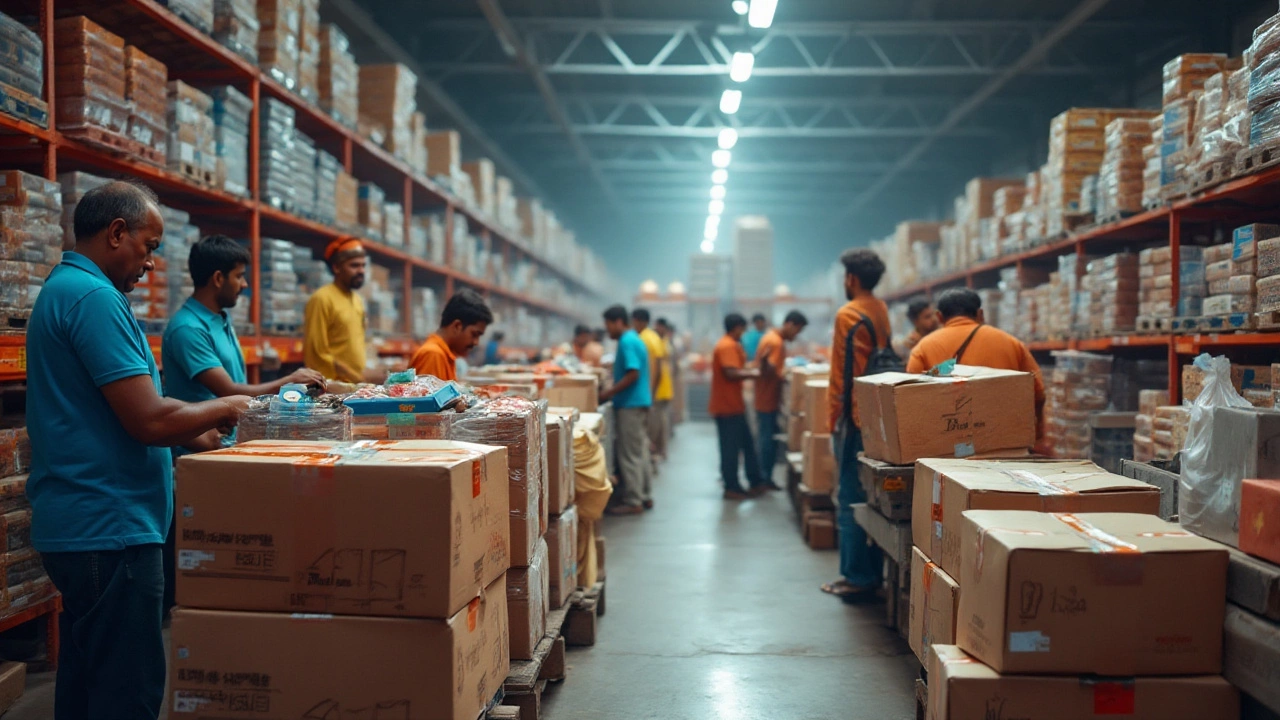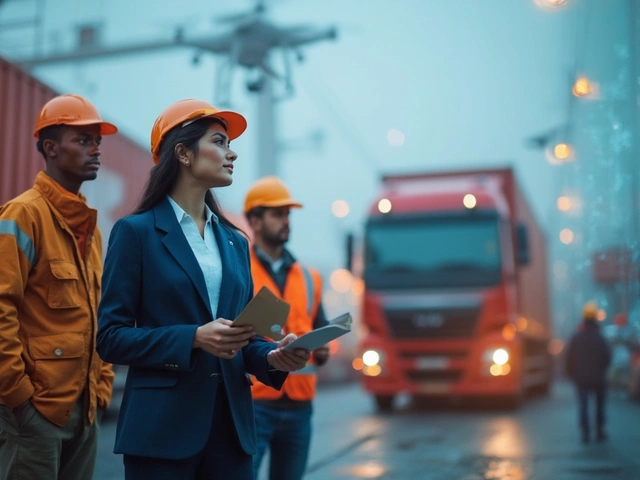When people think of eCommerce, they often picture a simple online transaction. Perhaps it's the ease of a quick click leading to a purchase that arrives at your doorstep. But the world of eCommerce is more than what meets the digital eye. Behind every transaction lies a complex web of logistics, integrating technology and traditional business practices to offer consumers a seamless experience.
Today, eCommerce embraces a wide array of operations, blending online and offline elements. From efficient warehousing strategies to innovative last-mile delivery solutions, businesses are constantly adapting to meet the growing demands of this dynamic field. Through understanding these hidden layers, we can appreciate the true breadth of eCommerce beyond just an online marketplace.
- The Definition of eCommerce
- Logistics Behind Every Click
- Warehousing: The Offline Backbone
- The Role of Technology in eCommerce
- Customer Experience and Logistics
- Future Trends in eCommerce Logistics
The Definition of eCommerce
When we talk about eCommerce, we're diving into the world of buying and selling goods or services using the internet, and the transfer of money and data to execute these transactions. While many equate it with online shopping, the scope is much grander. eCommerce can refer to any commercial transaction that is conducted electronically on any channel or device, be it your laptop, smartphone, or even your voice-activated assistants like Alexa.
Historically, eCommerce began in the 1960s with the development of Electronic Data Interchange (EDI), which allowed businesses to electronically exchange documents. It wasn't until the 1990s, with the advent of platforms like Amazon, that it became accessible to consumers on a larger scale. These transactions expanded rapidly, making their way into regular internet users' daily lives. Now, more than just buying goods, people can pay for services, subscribe to magazines, book tickets, and much more from the comfort of their homes.
The true breadth of eCommerce involves understanding its multiple components. These include Business-to-Consumer (B2C) transactions, Business-to-Business (B2B) operations, Consumer-to-Consumer (C2C) platforms like eBay, and even the newer Consumer-to-Business (C2B) models, where individuals sell products to companies. Each of these domains underscores the interconnectedness of commerce in the digital age, leveraging vast technological advancements.
An intriguing aspect often overlooked is how eCommerce intertwines with physical logistics. While the transaction might be initialised online, the product's journey from a warehouse to a customer's doorstep requires extensive logistics planning, including warehousing, inventory management, and delivering solutions to meet consumer expectations.
"The future of eCommerce is going to be driven by data, advancements in logistics, and the ability to create personalized experiences," says Daniel Zhang, CEO of Alibaba Group, shedding light on how vital logistics are in shaping future eCommerce landscapes.
Statistics reveal how massive the sector is becoming. According to Statista, global retail eCommerce sales are projected to reach 8.1 trillion USD by 2026. This exponential growth highlights the necessity for businesses to strategically engage with both the online and tangible elements of eCommerce to stay competitive and meet ever-evolving consumer demands.
Logistics Behind Every Click
The journey of a product from the point of purchase to the customer's doorstep is akin to a carefully choreographed dance. When the customer hits 'buy', it sets an intricate process into motion, often invisible to the end user but critical to their satisfaction. This is where logistics comes into play, an essential aspect of eCommerce that operates behind the scenes.
From inventory management to package delivery, logistics keeps the wheels of online shopping turning. The process starts with the systematic organization of goods within a warehouse, a task that requires precision and efficiency. Technologies like RFID scanning and automated picking systems have become the backbone of warehousing operations, allowing companies to quickly locate products and prepare them for shipment. These technologies not only streamline operations but also minimize the chances of human error, ensuring that customers receive exactly what they ordered.
Once items are picked, they must be carefully packed to withstand the journey ahead. Packaging is not just about protection; it's an integral part of the customer experience. Companies need to balance sustainability with safety, often opting for materials that are not only sturdy but eco-friendly as well. A sturdy package ensures that products arrive in pristine condition, while sustainable packaging aligns with the growing consumer demand for green practices.
Next, logistics involves choosing the right transportation modes to deliver products efficiently. This step might involve trucks, planes, or even drones in the near future, as logistics companies explore new ways to reduce delivery times. The global supply chain, though complex, is continuously evolving, adapting to changes in consumer behavior and technological advancements. According to the World Trade Organization, the value of global e-commerce transactions was estimated at $25.6 trillion in 2020, underscoring the magnitude of logistics in this sector.
One might wonder how all these elements come together seamlessly. It is the result of a meticulous orchestration, enabled by robust logistics management systems. These systems provide real-time tracking, exact delivery dates, and transparency throughout the process. As Matthew L. Cypher, a logistics expert, once stated,
"The success of eCommerce is tethered to the efficacy of logistics; without it, even the best online stores would crumble under the weight of inefficiency."
Lastly, the final aspect of logistics is the actual delivery of goods, or as it's often referred to, the 'last-mile'. The last-mile is where customer expectations are highest and where businesses can really set themselves apart. Reliable tracking information, prompt delivery times, and courteous service all contribute to a positive customer experience. Companies continue to innovate in this area, with some employing local couriers, using lockers for secure drop-offs, or utilizing real-time updates to keep customers informed.

Warehousing: The Offline Backbone
In the dynamic world of eCommerce, warehousing serves as the crucial offline backbone that supports the fluidity of digital transactions. Warehousing is much more than simply storing goods. Modern warehouses have evolved into complex hubs that facilitate the rapid movement of products, ensuring consumers receive their purchases on time. This evolution stems from the demands of the digital age, where the speed of delivery often directly impacts customer satisfaction and brand loyalty. Warehouses now function not only as storage spaces but also as vital processing centers where inventory management, order fulfillment, and shipping converge.
The strategic location of these warehouses is vital for optimizing the logistics involved in eCommerce. Companies often situate warehouses near major consumer bases to cut down transit times, which can drastically lower shipping costs and increase speed. This means that a product ordered with a single click in Toronto might have its journey begin from a bustling warehouse in Mississauga, cutting down a day or more of transit time. In the United States, giant retailers like Amazon have perfected this model, with numerous fulfillment centers across the country ensuring swift deliveries.
Warehouses today are integrated with superior technology to streamline operations. Automation plays a pivotal role, with robots and conveyor belts sorting, picking, and packing goods with precision. This technology allows for higher efficiency, reduced human error, and the capability to handle peak periods like Black Friday and Cyber Monday with ease. Many warehouses are now equipped with AI-driven systems that predict the best storage and retrieval methods to optimize space and time. Some pioneers in the field have even adopted drone technology for inventory checks, demonstrating a futuristic leap in warehouse management.
According to a report by the World Economic Forum, "The adoption of robotics and AI in warehousing has the potential to increase productivity by up to 30% within the next decade."
The importance of warehousing in eCommerce logistics is underscored by the rise of multi-channel retailing. As businesses sell products through various platforms, from their own websites to third-party marketplaces, warehouses must adapt to handle a mix of products and shipping options efficiently. This complexity requires sophisticated inventory systems that can seamlessly update stock levels across all channels, ensuring accurate data and preventing overselling.
The constant evolution of warehousing is further driven by sustainability demands. Increasingly, consumers are conscientious about the environmental impact of their purchases. Warehouses are responding by implementing green practices, such as using solar energy, improving insulation to save energy, and optimizing transit routes to decrease carbon footprints. Additionally, the incorporation of recyclable packaging materials into shipping processes aligns with modern consumer values.
In essence, the role of warehousing in eCommerce goes beyond mere storage. It's an essential component that bridges the digital and physical landscapes, enabling efficient service delivery and shaping the customer experience. As warehousing continues to evolve with technology and sustainable practices, it reaffirms its position as the indispensable pillar of the offline economy supporting the vibrant world of online eCommerce.
The Role of Technology in eCommerce
The landscape of eCommerce has been revolutionized by technology, weaving together various tools and platforms to create an efficient and cohesive system. At the heart of this change are innovations in data analytics, inventory management, and logistics, which influence how businesses operate and how customers interact with brands. Companies utilize data analytics to understand consumer behaviors, track buying patterns, and anticipate demands. This information allows retailers to tailor their offerings, optimize pricing, and enhance the shopping experience, encouraging customer loyalty and driving sales.
Inventory management systems powered by artificial intelligence (AI) enable real-time tracking of stock levels, which is crucial in maintaining a delicate balance between supply and demand. AI noticals need to predict when inventory will run low, automatically triggering replenishments and reducing the risk of stockouts. This level of automation minimizes costs while maximizing efficiency, ensuring that products are available when customers want them. As noted by a leading market analyst, "AI has transformed the way eCommerce companies manage their inventories, delivering accuracy and speed in ways that were unimaginable a decade ago."
Another significant contribution of technology in the eCommerce realm is the improvement of logistics. Advanced algorithms and automation play a key role in optimizing delivery routes and schedules, significantly speeding up the fulfillment process. This, in turn, has a profound impact on customer satisfaction as it enhances the delivery experience, promising faster and more reliable service. Cloud-based platforms allow different aspects of the supply chain to be interconnected, enabling seamless communication and coordination between all participants, from suppliers to customers.
Moreover, the advent of mobile technology has expanded the reach of online shopping. With smartphones becoming integral to our lives, mobile commerce (m-commerce) adapts online retail experiences to mobile devices, ensuring they are user-friendly and secure. Consumers can browse, compare, and purchase goods from virtually anywhere, at any time, contributing to the always-on nature of modern commerce. Businesses recognize the power of mobile engagement, investing heavily in apps and mobile-friendly websites to capture their audience's attention where they spend most of their digital time.
Interestingly, blockchain technology is starting to make waves in eCommerce logistics by enhancing transparency and security in transactions. With blockchain, every transaction is recorded on a secure, immutable ledger, adding a layer of trust and reducing the risk of fraud. Although still in its early stages, it's widely regarded as a game-changer, setting the pace for future advancements in secure online trade. As businesses continue to explore its potential, we might witness a fundamental shift in how transactions are authenticated and validated.
Finally, utilizing technology for improved customer service is crucial in retaining competitive advantage within the eCommerce sector. AI-driven chatbots and virtual assistants provide immediate assistance, guiding customers through the purchase process while addressing queries and concerns. These tools free up human resources, enabling teams to focus on more complex issues and fostering a harmonious consumer-brand interaction. It's a twofold benefit: customers enjoy convenient service, and companies optimize their operational workflows.

Customer Experience and Logistics
In the realm of eCommerce, logistics is the unsung hero that greatly influences the customer experience. When a buyer clicks 'purchase,' it's the intricate logistics network that ensures a smooth transition from the seller's warehouse to the customer's hands. The efficiency and reliability of this process can make or break a customer's perception of an online shopping platform. One might think it's just about moving packages, but in reality, logistics involves forecasting demand, managing inventory, and ensuring that each step aligns with customer expectations. Imagine ordering a product marked as 'available,' only to find it out of stock; this reflects poorly on the business, impacting trust and loyalty.
The customer journey doesn't end after the purchase is made. It extends to how the product is packaged, how quickly it arrives, and what happens if there are returns or exchanges. Many companies are investing in robust supply chain strategies to enhance this aspect, creating a direct line of feedback between logistical teams and customer service. According to a survey by Deloitte, 70% of consumers state that a bad delivery experience would prevent them from ordering from a particular retailer again. This underlines the importance of seamless logistics in fostering repeat business and positive word-of-mouth.
Let's delve deeper into the elements at play. Warehousing is where it all begins. Modern warehouses are no longer mere storage spaces; they are dynamic hubs using advanced technology for inventory management. Radio Frequency Identification (RFID) and automated systems track product movement in real-time, enabling quick preparation for dispatch. The next critical step is transportation, where companies focus on minimizing delivery times and costs. Companies like Amazon have set high standards with their same-day and next-day delivery services, nudging competitors to innovate constantly.
In the last-mile delivery phase, the rise of gig economy workers and crowd-sourced delivery models has transformed the landscape. Firms such as Instacart and Postmates leverage local couriers to offer personalized delivery solutions, enhancing the convenience factor for customers. Some retailers even use drones and autonomous vehicles to tackle delivery challenges in hard-to-reach areas. By adapting to new methods, businesses aim to optimize efficiency while keeping customers satisfied.
Technology is pivotal in reshaping the logistics sphere. With predictive analytics, companies forecast demand patterns, adjust inventory levels, and manage fleet logistics. These strategies allow businesses to meet international demands while addressing local preferences. Artificial intelligence and machine learning models enable better route planning, ensuring faster deliveries and reducing shipping costs. According to McKinsey & Company, advanced analytics can lead to a 15% improvement in logistics costs, offering a competitive edge in the bustling eCommerce space.
Environmental concerns are shaping logistics strategies too. Many consumers now prefer companies with sustainable practices, pushing businesses to adopt eco-friendly solutions. Electric delivery vehicles, reusable packaging, and carbon-neutral shipping options are gaining traction. A report by the Consumer Technology Association reveals that 63% of consumers are more likely to purchase from companies with environmentally responsible practices. This trend ultimately shapes new norms in customer expectations regarding eCommerce logistics.
Future Trends in eCommerce Logistics
The future of eCommerce logistics is a constantly evolving landscape that challenges traditional concepts while seizing opportunities presented by rapid technological advances. The next wave of innovation promises to redefine how businesses manage their supply chains, ensuring that goods move more efficiently from warehouses to the hands of customers around the globe. With rising consumer expectations for faster and more reliable delivery, companies are investing heavily in advanced technology to stay competitive. This focus on speed and efficiency is driving major transformations in the industry, influencing everything from distribution center locations to the means of transportation themselves.
One prominent trend shaping the future is the increasing use of automation within warehouses. Automated systems such as robots and AI-driven tools are becoming integral in sorting, packing, and even shipping items with precision and speed that human labor alone could never match. Automation reduces errors and enhances efficiency, making the supply chain smoother and more responsive. For example, Amazon has been a pioneer in using robots to assist with sorting in its fulfillment centers, reportedly cutting down on processing time by nearly half. However, the role of human oversight remains essential in overseeing these automated systems to ensure quality and handle any exceptions.
Another emerging trend is the application of advanced data analytics to predict and respond to demand fluctuations. By leveraging big data, companies gain insights into consumer buying patterns, seasonal trends, and potential supply chain disruptions. This data-driven approach enables businesses to optimize their inventory levels, reducing the risk of stockouts or overstock scenarios that can impact both revenue and customer satisfaction. According to McKinsey, data analytics have the potential to reduce transportation costs by up to 15%, underscore the profound impact of these modern capabilities in shaping eCommerce efficiency.
The exploration of sustainable practices in logistics is also gaining traction as environmental concerns become more pressing. E-commerce giants are exploring renewable energy sources to power logistics facilities and reduce their carbon footprints. Many companies are opting for electric vehicles for last-mile delivery, which is often the most polluting part of the delivery chain. In 2021, UPS began testing electric delivery trucks in urban centers, hoping to expand this fleet significantly in the coming years. The focus is not just on the mode of transportation but also on reducing packaging waste through minimalistic designs and the use of recycled materials.
"Our challenge and opportunity lie in making the logistics processes not only efficient but also environmentally responsible," noted a recent report from the World Economic Forum.In addition, the convenience and flexibility provided by innovations like drone deliveries and autonomous vehicles are no longer just futuristic concepts but are fast becoming a reality. Companies like Zipline and Wing have already started trial deliveries using drones in select regions, offering rapid delivery times for light-weight items. As regulatory environments evolve and infrastructure develops, these technologies stand to revolutionize how we perceive delivery logistics.
Finally, as eCommerce businesses grow globally, the importance of seamless cross-border logistics cannot be overstated. Companies are increasingly establishing partnerships with international logistics providers to smooth over challenges related to customs, tariffs, and differing regulations. The ability to navigate these complexities efficiently can offer businesses a competitive edge in reaching international markets. In summation, the future of eCommerce logistics is a tapestry of innovation, sustainability, and collaboration. It promises not just to meet but to exceed the sophisticated demands of the modern consumer.





